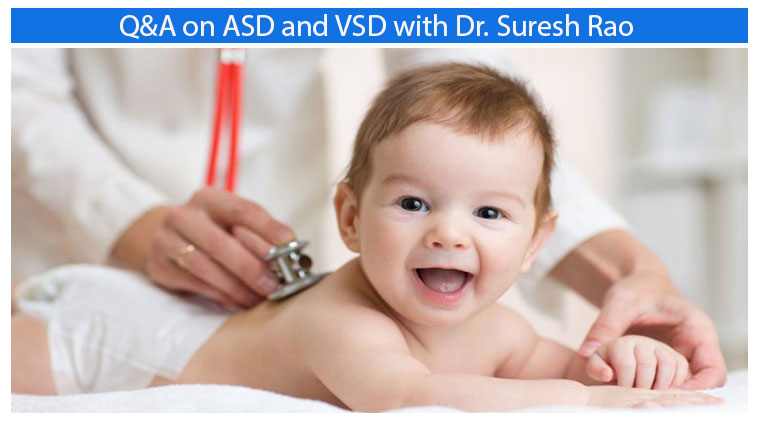Dr. Suresh Rao:
Director, Children’s Heart Centre and Consultant, Pediatric & Congenital Heart Surgeon, MBBS, MS (Gen.Surg), MCh (CVT Surgery), Dip. NB (CT Surgery), FIACS.
Dr. Suresh Rao heads the Children Heart Centre at Kokilaben Hospital in Mumbai, India. He has more than 25 years of experience in the field of Paediatrics & Congenital Heart Surgery and has performed more than 12,000 surgeries.
Before joining Madras Medical Mission (MMM) at Chennai, Dr. Rao got his training of CVT Surgery from Sree Chitra Institute Trivandrum. Later he worked at New Zealand, Australia and USA and got trained in Pediatric and Congenital Heart Surgeries.
In India, Dr. Rao has pioneered the practice of Modified Ultrafiltration after Congenital Heart Surgery and is equipped with, Special skills for simple and complex heart defects, cosmetic approaches and valve repairs including Congenital Heart Surgery in neonates, infants, children and adults.
1. What is Congenital Heart diseases?
Ans – Congenital heart disease is the defect in the heart which is present since the heart is being formed in mother’s womb.
2. Can we detect Congenital heart defect?
Ans – Yes, We have the technology like “Ultrasound” which can detect the congenital heart defect before birth. The best time to detect is between 16 to 18 weeks of pregnancy.
Related Post – What is ASD repair procedure and its symptoms
3. Is it a proper cardiac test?
Ans – Yes. however, the ECHO test has to be performed by a trained pediatric cardiologist. A doctor will counsel the parents about the defect, whether it required the surgery or not and what’s the quality of life a child will be having. The parents can be informed about all these before the child is born.
4. Is this procedure only present in India?
Ans– This technology is pretty well established in North America and European countries. In India it is growing, it can be seen in metro cities. Only it has to be performed by the specialist (pediatric cardiologist)
5. What is ASD?
Ans – The atrial septal is the hole in the wall between two upper chambers of atria. About 1 on every 100 babies is born with a congenital heart defect. ASD is the simplest form in Congenital heart defect. the defect type could be complex or simplest. ASD doesn’t cause very much problem after birth. But as the child grows the presence of the hole leads the child to low in the weight, activity wise child is normal.
Left untreated this ASD can be trouble in the later part of life, it is recommended to fix this lesion before school going age. Straight forward simple ASD is also called as “Secundum ASD” usually detected accidentally either in school, or when the child has gone for some other problem while checking with a stethoscope if doctor hears a murmur they get the ECHO test done and then ASD in seen.
[youtube https://www.youtube.com/watch?v=3mWHB6NamCg?rel=0&controls=1;showinfo=0&start=1]
ASD can be small, large or big in size., Mostly tiny ASD doesn’t require treatment, it might close up on its own as the child grows up, we treat moderate to large ASDs.
Complex ASD requires surgeries certainly, but for the simplest form we have surgical treatment now, which is called a “closure of device”. For this treatment, we required a certain prerequisite and that should be assisted by a cardiologist before we proceed a device Closure. If you can’t close by the device, a surgery has to be done which is pretty close to open heart surgery and in today’s practice gives 100% success rate. Once the surgery is done the child is a cured for the lifetime. They can live a normal life, can take part in sports, girls can become a mother. There is no side effect of this surgery.
Related Post – ASD- What are the types, treatment and Best Doctors?
6. What is the ideal age for ASD treatment?
Ans – Generally in ASD, we don’t need to treat when the child is very small, unless any indication. if they don’t gain weight or a child don’t feed well.
Usually, the ideal age is 2 to 5 years of age. and certain before school going age.
7. Is there any weight specification?
Ans – There is no specific weight condition. we treat whenever the indication arises.
8. In Africa, they have a rule they don’t treat a child below 10 kg, do we follow such rule?
Ans – We have the specialized unit for children. We are operating new-borns to up forwards. It’s an indication in which the surgery has to be done.
9. How many days should a child have to be admitted in Hospital?
Ans – For ASD’s, to do the basic blood test, we admit the child a day before surgery and after surgery, for observation, they have to stay for 5 to 7 days. For non- surgical treatment, they can get a discharge within 3-4 days. For girls particularly, we perform the surgeries from the back, so that there is no scar in the front and it is only cosmetic. We assure parents that there is certainly no risk in this approach, so parents of girl child prefer that we perform the surgery from the back.
Related Post – Know the Treatment for Ventricular Septal Defect
10. What different technology we used in India on ASD treatment?
Ans – The expert team who does a lot of these procedures. Till date, we have done thousands of such surgeries, in fact, ASD is the first surgery any cardiac surgeon starts with. The cardiologist uses hundreds of devices. In such an extremely critical procedure, an experience of a cardiologist and the surgeons matters a lot.
11- What is the cost comparison as compared to USA or Singapore?
Ans – Well, there is no comparison, we are close to about 10th of their cost with a similar or higher success rate.
12. What is VSD?
Ans – The second common lesion is VSD (Ventricular septal defect) in congenital heart diseases. It is more common than ASD. VSD’s are trickier as they have a hole between the pumping chamber of the heart. The amount and the pressure of the blood going to the lung complicates the VSD as compared to the ASD.
If a child is born with VSD, the size of VSD depends on a lot how a child is going to behave. If it’s a small VSD, it’s good for the child. If its large VSD the child become symptomatic earlier. In a new-born child, some kind of VSD’s tends to come down in size in a few months’ time. And some of them may be lucky to close on its own. Whenever we see a VSD in the new-born child we don’t try to rush in and close the VSD. If it is only a VSD and not with any other problem, we try to give a child a months’ time, monitor it closely on how it feeds, how it grows and at the end of one month usually the VSD shows itself, how it is going to behave in future. So generally, the VSD’s are close anywhere between two to three months upwards. But certainly, large VSD’s have to be close by the 6th month of age because we know that if we leave it for too long the large VSD can cause damage to the lungs.
Related Post – VSD Symptoms every parent should know
13. What advice do you give to the parents whose child have similar symptoms and what are the advanced equipment we have so a patient is willing to travel to India?
Ans – If the child is two to three months of age having large VSD, making a child symptomatic like not feeding well and has lost weight, I would prefer that such VSD get close at our center. because they are extremely delicate children and they required a full unit of children’s heart surgery specialist for them to recover. Having a specialized center in India, two to three-month age child having VSD is not considered a very complex problem. Usually, they get operated and about 8 days’ time they can go home.
14. Does VSD have the same success rate?
Ans – Yes, VSD is close to 100% success rate.
[youtube https://www.youtube.com/watch?v=Yx8HRsQHo9Y?rel=0&controls=1;showinfo=0&start=1]
15. Is there any non- surgical VSD?
Ans – There are few VSDs which can close non-surgically also. But, this usually happens in older children, VSD’s are away from some of the important structure of the heart. They have to be chosen very carefully by the cardiologist depending on the ECHO.
16. Do children with ASD VSD need regular follow-up?
Ans – Yes, For ASD after 4 to 5 years of age they are free from the follow-up. Similarly, with VSD. However, in some VSD cases, the kids need to follow up unto 5-7 years of the age, especially those with large VSD and high lung pressure. They need a follow up to see what is happening to the lung pressure. Even a small percentage can continue to have high lung pressure.
Related Post – Dr.Suresh Rao
17. For follow up, do they need to travel to India?
Ans – For ASD may be every year they have to come for the follow-up checks or they can get the same done locally and send us the adequate report.
For large VSD they can get the ECHO done locally and send us the ECHO report.
18. What is more complex in the kids’ heart?
Ans – After ASD and VSD, there is PDA or Coarctation
Magnus Medi helps you to get the best treatment at an affordable price by connecting you to best hospitals and doctors in India, Best Neurosurgeon in India

